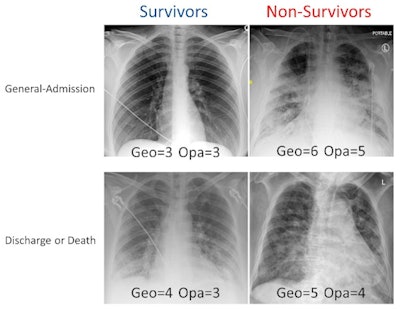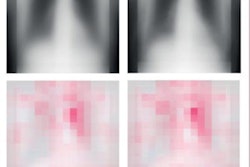
Plain chest x-rays of COVID-19 patients taken at the time of hospital admission can help predict which patients are at higher risk of death, according to a group of researchers in New York.
A team led by Dr. Beiyi Shen of Stony Brook University in Stony Brook found that chest x-ray severity scores were significantly worse at admission in patients who died compared with those of survivors. These chest x-ray scores can be used to inform clinical decisions, they suggest.
"These [findings] are not unexpected, but indicate correlation of severity of COVID-19 infection with likelihood of mortality, and [chest x-rays] could provide clinically useful information in a quantitative manner," the group wrote. The study was published March 15 in Diagnostics.
Although chest x-rays are inferior to CT for diagnosing COVID-19, they were used widely during the peak of the pandemic and continue to be useful in resource-limited settings around the world. Chest x-rays can visualize characteristic ground-glass opacities and consolidation in the lungs associated with COVID-19 infection and help with clinical diagnosis.
However, there has been no systematic evaluation of the longitudinal characteristics of lung chest x-ray scores in COVID-19 patients, the group wrote. Thus, in this retrospective study, the group aimed to further establish whether findings on chest x-rays can be associated with patient outcomes.
Shen and colleagues compared chest x-ray scores among survivors (224) versus nonsurvivors (28) in a general group of patients and among survivors (92) and nonsurvivors (56) in a group of patients who were put on invasive mechanical ventilation. Radiologists analyzed each x-ray and scored the images on a scale of 0 to 8, with a higher score indicating worse disease. The investigators then analyzed correlations between the chest x-ray scores and outcomes at different time points. The primary study outcome was mortality.
 Examples of chest x-rays with different geographic extent and opacity scores. Chest x-rays of COVID-19-positive patients were scored (range, 0-8) based on the extent and degree of opacities. Image and caption courtesy of Diagnostics through CC BY 4.0.
Examples of chest x-rays with different geographic extent and opacity scores. Chest x-rays of COVID-19-positive patients were scored (range, 0-8) based on the extent and degree of opacities. Image and caption courtesy of Diagnostics through CC BY 4.0.For the general group of patients, non-survivor chest x-ray scores were significantly worse at admission compared with those of survivors (p < 0.05), the researchers found. For ventilated patients, survivor and nonsurvivor chest x-ray scores were similar at intubation (p > 0.05).
The researchers found that chest x-ray scores were significantly correlated with other clinical variables for disease severity, such as lactate dehydrogenase, respiratory rate, D-dimer, C-reactive protein, procalcitonin, ferritin, SpO2, and lymphocyte count (p < 0.05).
"These findings suggest that mechanical ventilation treatment improved [chest x-ray] scores and patient overall outcomes," the authors wrote. "They also suggest that [chest x-ray] scores are informative and could be used to monitor disease progression."
In the end, chest x-rays have become increasingly relevant in COVID-19 diagnosis and treatment because a disproportionally large percentage of COVID-19 patients are put on invasive mechanical ventilators for a much longer duration compared with other similar lung infections, the group wrote. That's why a better understanding of the temporal progression and disease severity of COVID-19 lung infection on chest x-rays has become more urgent.
"These results suggest that longitudinal chest x-ray scores have the potential to help predict prognosis, guide treatment, monitor disease progression and allocate resources in COVID-19 circumstances," the researchers concluded.



















